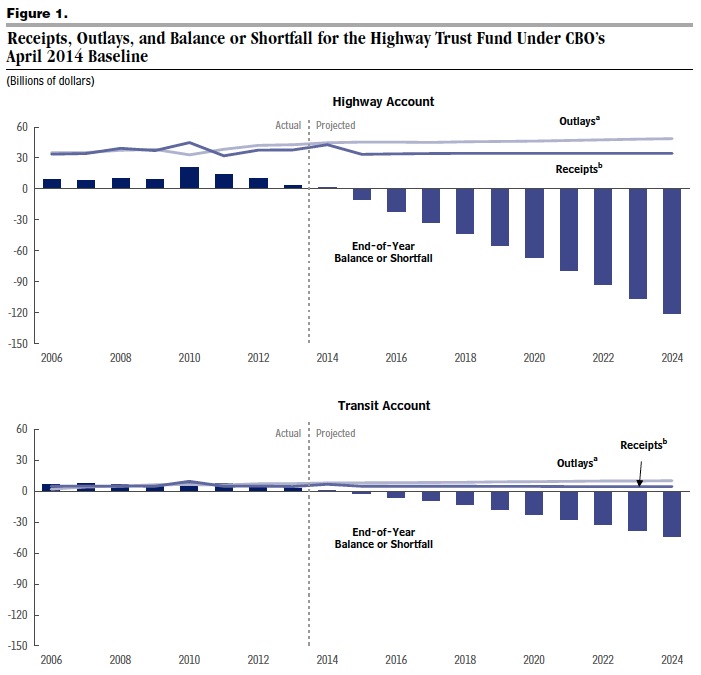CONGRESSIONAL BUDGET OFFICE
Summary
The federal government spends more than $50 billion per year on surface transportation programs, mostly in the form of grants to state and local governments. Much of this spending is for highways and mass transit programs financed through the Highway Trust Fund. Those programs have an unusual treatment in the federal budget, and the way they are classified in the budget facilitates the spending of more money from the trust fund than there are dedicated revenues to support such spending. Those revenues come from excise taxes on the sale of motor fuels, trucks and trailers, and truck tires, and from taxes on the use of certain kinds of vehicles.
This report of the Congressional Budget Office (CBO) describes the status of the Highway Trust Fund and options that the Congress might consider to address the imbalance between revenues and spending from the fund. Part of the discussion concerns the transportation programs’ unique budgetary classification and how that treatment limits the effectiveness of the standard mechanisms for budgetary control.
Spending From the Highway Trust Fund Exceeds Its Revenues
In the past 10 years, outlays from the Highway Trust Fund have exceeded revenues by more than $52 billion, and outlays will exceed revenues by an estimated $167 billion over the 2015–2024 period if obligations from the fund continue at the 2014 rate (with adjustments for future inflation) and the expiring taxes on fuels and heavy vehicles are extended at their current rates. Since 2008, lawmakers have addressed those shortfalls by transferring $54 billion, mostly from the general fund of the Treasury, to the Highway Trust Fund. Under current law, the trust fund cannot incur negative balances, nor can it borrow to cover unmet obligations. To match the trust fund’s resources with its spending, lawmakers could choose to authorize additional transfers, reduce spending for surface transportation programs, boost the fund’s revenues, or adopt some combination of those approaches.
Surface Transportation Programs Have a Split Budgetary Classification
Federal programs obtain the authority to incur financial obligations (referred to as budget authority) either in permanent law or in annual appropriation acts; the spending to pay for those obligations is recorded as outlays in the budget. Budget authority and outlays derived from annual appropriation acts are usually classified as discretionary, and those derived from other laws are labeled mandatory. Generally, the budget authority and outlays of a federal program are both classified in the federal budget as either mandatory or discretionary. However, since 1988, for the surface transportation programs examined in this report, the budget authority has been classified as mandatory while the outlays have been classified as discretionary.
Most Procedures for Controlling Federal Spending Do Not Apply to Spending for Surface Transportation
The processes that the Congress uses to manage the budget— procedural points of order and other Congressional rules designed to control budget deficits—are largely designed to monitor either a program’s mandatory outlays or its discretionary budget authority. But, with mandatory budget authority and discretionary outlays, surface transportation programs funded from the Highway Trust Fund are generally not subject to the processes that control spending for most other programs:
Spending for mandatory programs is usually subject to certain reductions—mostly across-the-board cuts— under budget rules. However, outlays for the trust fund’s surface transportation programs are not subject to those rules because they are considered discretionary.
Spending for most discretionary programs is controlled by statutory caps on discretionary budget authority. However, outlays for the trust fund’s surface transportation programs are not constrained by those caps because the budget authority for those programs is considered mandatory.
That split budgetary treatment allows programs funded by the Highway Trust Fund to skirt budgetary control mechanisms and makes understanding the potential budgetary implications of legislation more difficult for policymakers and transportation stakeholders. (How CBO displays transportation funding in its cost estimates is explained in Anatomy of a Cost Estimate for Legislation Funding Transportation Programs, June 2014, www.cbo.gov/publication/45398.)
About the Congressional Budget Office (CBO)
www.cbo.gov
“Since its founding in 1974, the Congressional Budget Office (CBO) has produced independent analyses of budgetary and economic issues to support the Congressional budget process. The agency is strictly nonpartisan and conducts objective, impartial analysis, which is evident in each of the dozens of reports and hundreds of cost estimates that its economists and policy analysts produce each year. All CBO employees are appointed solely on the basis of professional competence, without regard to political affiliation. CBO does not make policy recommendations, and each report and cost estimate discloses the agency’s assumptions and methodologies. All of CBO’s products apart from informal cost estimates for legislation being developed privately by Members of Congress or their staffs are available to the Congress and the public on CBO’s website.”
Tags: CBO, Congressional Budget Office, Highway Trust Fund, Surface Transportation







 RSS Feed
RSS Feed